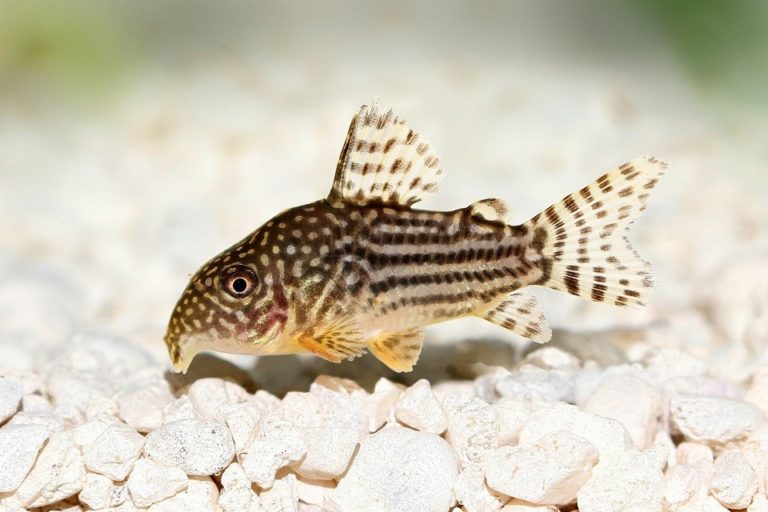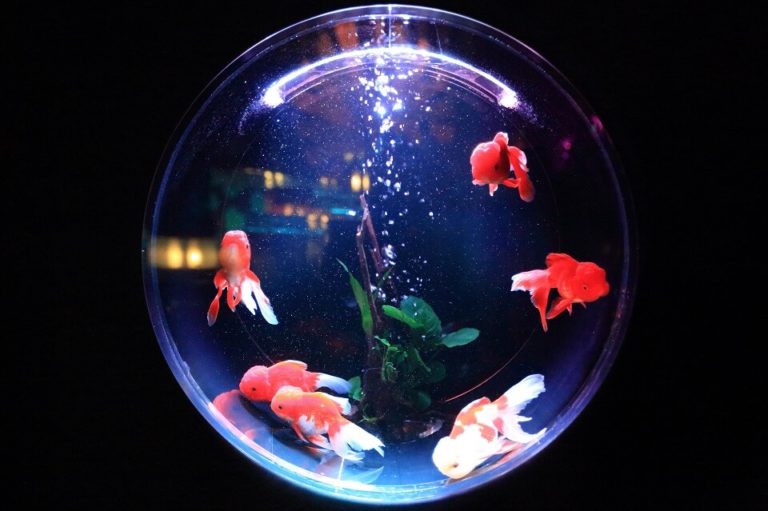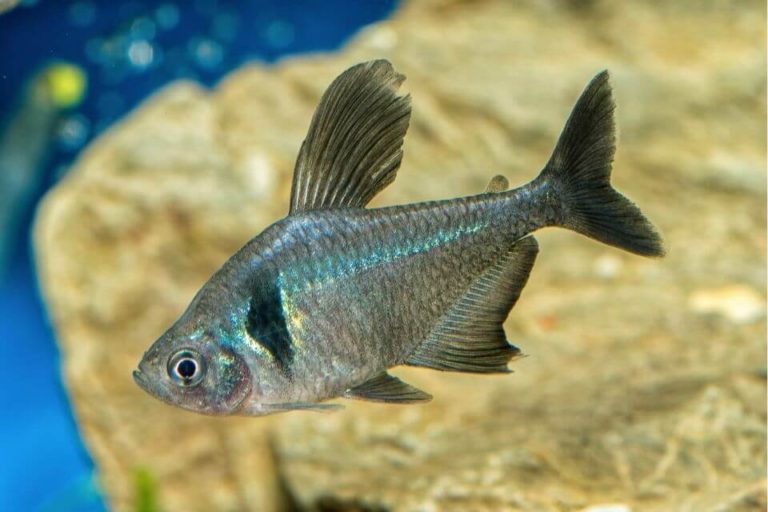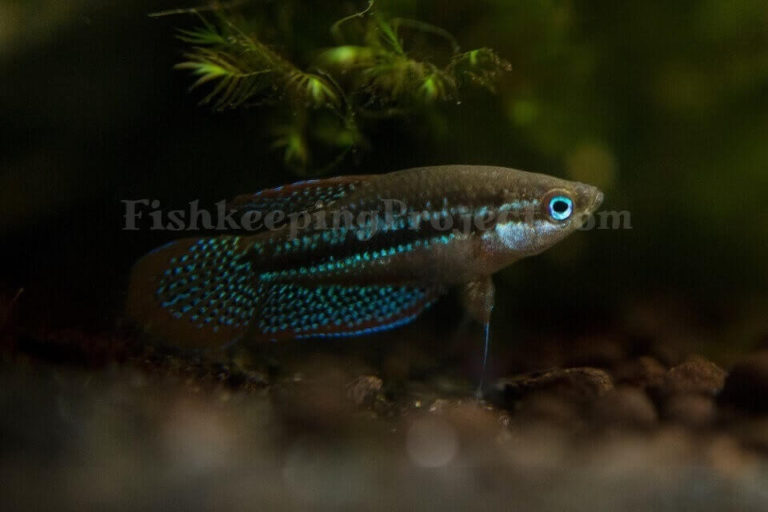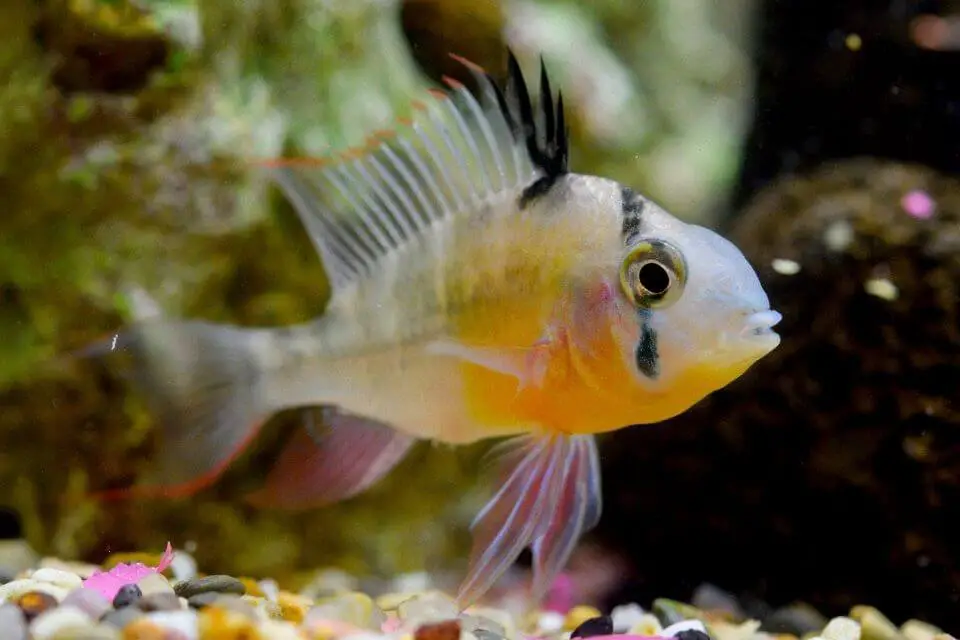Yoyo Loach Care Guide – Tank Setup, Tank Mates, Diet, and Breeding
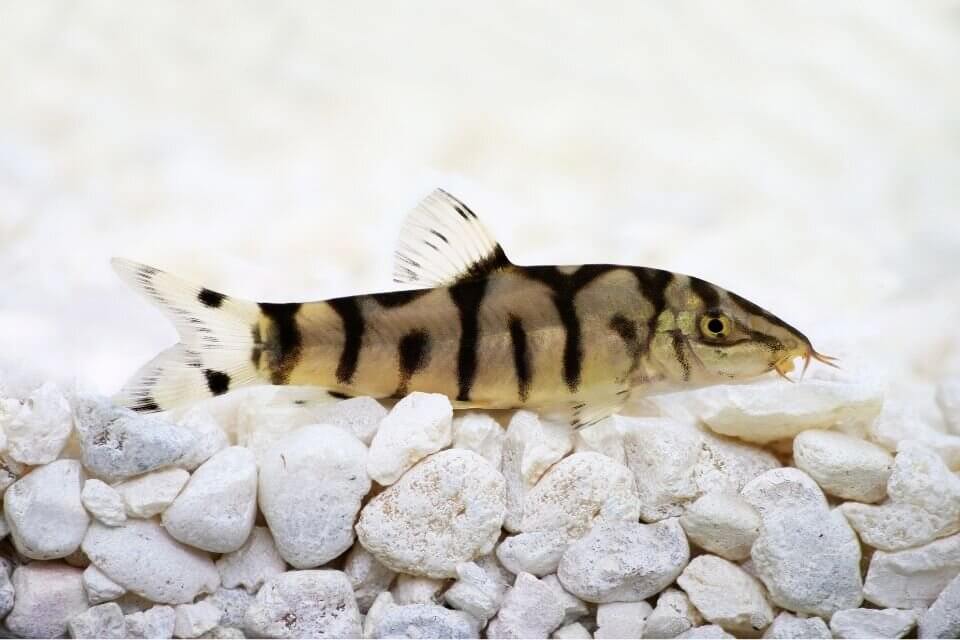
The Yoyo Loach brings an element of interest to your freshwater aquarium. Their shimmery silver bodies with black patterns create a fantastic look. The pattern seems like the word ‘Yoyo’ imprinted on their bodies, which is one reason for the name Yoyo Loach.
Their temperament makes them a fine choice for the tank as they are generally peaceful species. Sometimes, they can be aggressive with other members, but they generally do not make trouble with other peaceful species in your fish tank.
Overall, these active fish species are a must-have in the aquarium. This guide will let you know everything you need to learn about caring for Yoyo Loach to prepare yourself to have them in your freshwater aquarium.
| Quick Facts: | |
|---|---|
| Common Names | : Yoyo Loach, Almora Loach, Pakistani Loach |
| Scientific Name | : Botia almorhae |
| Family | : Botiidae |
| Origin | : Water basins of River Ganga in northern India |
| Care Level | : Intermediate |
| Lifespan | : 5 - 8 years |
| Size (average) | : 2.5 inches long |
| Diet | : Omnivores |
| Breeding | : Egglayer |
| Social | : Shoaling fish |
| Temperament | : Peaceful |
| Minimum Tank Size | : 20 gallons |
| Temperature | : 75 - 86 °F (24 - 30 °C) |
| Water Hardness | : 3 - 12 dGH |
| Water pH Level | : 6 - 8 |
Overview of Yoyo Loach
The scientific name of the Yoyo Loach species is Botia almorhae, which gives it another name the Almora Loach. It is sometimes also called the Pakistani Loach because of its origin. However, the fish is generally more popular by the name Yoyo Loach for two known reasons.
Photographer Ken Childs noticed that the pattern on the fish’s body resembled the word “Yoyo” and appeared similar to a child’s toy when they swam up and down in the water.
Origin, Distribution, and Availability
Loaches are usually classified into five families, namely, Botiidae, Balitoridae, Cobitidae, Nemacheilidae, and Vaillantellidae. The Yoyo Loach belongs to the Botiidae family.
These freshwater species originated in still and slow-moving water basins of River Ganga in northern India and Nepal. It’s not directly related to Pakistan, and all its sources point towards the Indian Gangetic basin, but there is a specific reason for the alternative common names.
The native habitat of these species the Ganga River, which flows through both India and Pakistan. Almora Loach, the other name by which it is also known, refers to a place called Almora in the state of Uttarakhand in the northern part of India.
The Yoyo Loach is widely distributed throughout Asia and Middle Eastern countries. This species is diverse, and they are easily available. It is not hard to find Yoyo Loach for sale in your local pet stores and even online.
Yoyo Loach Behavior
Yoyo Loach exhibits slightly different than other loaches. These are not nocturnal fishes. Once they get familiar with the tank, they remain active all day. You will find the fishes actively moving at the bottom of the fish tank throughout the day. Almora Loach will most probably be looking for food near the crevices or the planted areas at the bottom.
They adjust well with other species as they can keep to themselves without disturbing the peace, but they are not shy species in nature. These species may fight for themselves if they get into trouble, but they interact well with other species in general.
They sometimes get aggressive towards members of their same species, but that’s definitely not a reason not to keep them together.
Characteristics of Yoyo Loach
Let us now look at the details of the specific characteristics of Yoyo Loach. It is important to know about their appearance, colors, and lifespan before you own them.
Appearance, Colors, and Special Markings

Yoyo Loach has a zebra-like appearance, even though the patterns and markings are different. It’s the black patterns on the white body that gives the zebra-like impression to these fish species.
The base color is silvery white with black patterns on them. But the black markings often exhibit a hint of blue from the edges, which makes them look even more beautiful.
Imagine these fishes swimming under the aquarium lights, radiating a beautiful blue tint from their black markings and silver bodies. Some fishes have more prominent lines and dots, while others have thinner or pale lines.
The black bars get split at the dorsal area, alternated by black dots, giving the impression of the letters ‘Y’ and ‘O’ on the body. The bodies are slender with translucent fins and a small head. The shape of the head is conical, with a little snout and four barbels. This is one of the most important identifying factors.
Size: How Big Does a Yoyo Loach Get?
Yoyo Loach size has an average length of 2.5 inches when they reach complete growth. The size of these species depends on the diet, care, and tank size that receive. In the wild, they may even grow up to 5.5 to 6 inches.
They may attain the wild Yoyo Loach size in captivity, but you need to provide them with a large tank space to give them enough space to grow and provide a proper and healthy diet. However, that doesn’t guarantee an increase in growth but there is a chance of growth with optimal care.
The lifespan of Yoyo Loach
The average Yoyo Loach lifespan is between 5 to 8 years when kept in captivity. However, experienced aquarists may even extend the Yoyo Loach lifespan with proper care and diet. Almora Loaches in the wild survive much longer than captivity species.
Tank maintenance is vital if you wish to extend the Yoyo Loach lifespan. Always try to maintain the below discuss tank conditions and water parameters to give them a long life.
Aquarium Care and Conditions
It isn’t difficult to care for Yoyo Loaches if you follow certain conditions regarding their care and tank. It’s always better if you are an experienced aquarist or fishkeeper, but beginners can also keep them healthy.
Follow the recommended requirements and conditions for the aquarium below.
Tank Conditions and Care
In their natural habitat, these fish species remain in still and slow-moving water bodies. They stay in small bends of rivers where there are more rocks. It makes the conditions suitable for them to satisfy their natural urges to look for food frequently. They also love to keep to the bottom and hide in the crevices and between the rocks.
In captivity, Almora Loaches need stable water conditions in the tank to mimic the natural habitat. They do not respond well to water fluctuations. In the tank, too, they love to swim near rocks, plants, and gravel. They give them natural cover and give them enough chances to explore the crevices and look for food.
Yoyo Loach tank size
Yoyo Loaches need a minimum of 20 gallons of a tank when they are young. But when they grow bigger, they need more space to swim. You need to shift them to a 40 gallons tank when the loaches are grown up.
However, the size of the required gallon of water depends on the number of Yoyo Loaches you own. Therefore, a group of 5 would need more than 100 gallons at least. Basically, think of adding 15 gallons per one Almora Loach if you plan to accommodate more than one in a tank.
Tank Setup
Even when you keep these fish species in your home aquarium, you must set up the tank to mimic their natural wild habitat. The ideal way to set up the tank is to introduce plants, branches, rocks, gravels, bogwood, and slate in the tank, along with low-lighting conditions.
Also, keep in mind that you must have enough swimming space for the fishes.
- Lighting: They require subdued lighting to remain comfortably in the tank. Diffused lighting would be the best in this case.
- Plants: They need plenty of greenery in their tank. Arrange them along the sides of the tank, keeping the middle free for swimming.
- Rocks and Substrate: Loaches also need a smooth sand or gravel substrate at the bottom. They need ornamental resins, rocks, and driftwood to hide and explore. These fishes tend to migrate during their lifespan. They love to spend some time in rocky areas and migrate to areas full of plants when they wish.

Suitable Plants
The most suitable plants for the tank would be low-light options like Anubis, Swords, Crypts, and Java Fern. These fishes can be destructive with certain plants and uproot them. You need well-rooted plants around Yoyo Loaches.
Almora Loaches do not prefer bright lights, and thus, growing plants in the aquarium may require some fertilizers. Floating aquarium plants also might be a good alternative. It reduces the brightness in the tank because these fish species prefer a low-light environment.
However, do not crowd the tank with too many plants. Loaches need plenty of space to swim and rocks, gravel, and crevices to hide and explore, searching for food.
Water Temperature and Parameters
To keep the Yoyo Loaches happy and healthy, you must provide them the similar water conditions as their natural habitat. Since they live in still and slow-moving riverine water in India, they need slightly warmer and acidic water.
It is crucial to maintain these water parameters:
- Temperature: 75 to 86 °F (24 to 30 °C)
- Water acidity: 6.0 to 8.0 pH
- Water Hardness: 3 to 12 dGH
It is also important to maintain these temperature levels, pH, and hardness range regularly to keep the fishes healthy. Keep a consistent check on the water in the tank to avoid fluctuations and chances of diseases.
Diet: What do Yoyo Loach Eat?
Wild Yoyo Loaches are scavengers, and they hunt their surroundings to feed on crustaceans, insect larvae, plant matters, and anything that suits them. They keep hunting for food frequently to satisfy their hunger.
Almora Loaches have a great appetite and need to be fed adequately several times a day when kept in a fish tank. They need small meals after every few hours to remain strong and healthy. However, overfeeding can be dangerous for these sensitive fishes.
You can include almost any kind of fish food in the diet. Use sinking pellets while giving them dry foods so that they reach the bottom. The fishes generally flock near the bottom of the tank and rarely come up to the surface to eat.
Additionally, you can also feed them live food like earthworms, snails, brine shrimps, daphnia, etc. Small freshwater snails are a favorite food for Yoyo Loaches. Therefore, it means that they eat whatever you give them in the tank.
You can also introduce some fun into the aquarium for these playful fishes during feeding time. Put the food in different parts of the aquarium to let them look for the food and hunt them out. This would give them some activity along with satisfying their appetite.
Common Diseases of Yoyo Loach
Yoyo Loaches have thin scales, which makes them vulnerable to diseases. These sensitive fishes are very prone to illnesses and are the first species in the tank to get affected. Their tiny scales do not offer them much protection compared to other scaly fishes. Thus, whenever there is a chance of a fungal infection in the tank, they get affected before others.
To make matters worse, Yoyo Loaches are sensitive to treatment as well. They need half the dose of medicines generally administered to fishes.
However, there are no specific diseases that occur with Yoyo Loaches. Other freshwater fishes may fall sick and spread the illness to sensitive fishes like the Almora Loach. A common sickness that ails most sensitive freshwater fishes is Ich. It causes white spots on the body and the fins. This parasitic disease easily attaches loaches because they are more vulnerable and lack protection.
Whenever you notice any sign of disease in a fish, remove it to a different tank for treatment. This prevents the chances of affecting the other fishes in the tank. Similarly, if you find symptoms of illness in a loach, move it to a separate tank having the same water conditions. Provide it with food, medications, space, and proper care in the separate tank to nurture it back to health.
Also, remember to clean the water in the aquarium frequently to maintain water quality. Clean and fresh water keeps your fishes healthy. Maintain the water conditions, keeping it stable to avoid fluctuations and parasitic growth.
Yoyo Loach Gender Differences
It is hard to tell the differences between males and females in Yoyo Loaches. It becomes noticeable only when the females lay eggs. Generally, the males are slimmer than the females. The belly becomes fat when they are mature and full of eggs. At times, the males show a tint of red near the barbels, which the females do not.
Yoyo Loach Breeding
Almora Loach usually does not breed in captivity. There are no known methods to make them breed in the tank. They tend to swim upstream and migrate during the breeding period when they are in the wild. Migration is unthinkable inside an aquarium, which is a vital factor for reproduction in this species.
Therefore, it’s impossible to make Yoyo Loach breeding in the tank. Yoyo Loaches come to the market from the wild because even professional breeders do not succeed much with breeding.

Yoyo Loach Tank Mates
It is always best to have a small group of Almora Loaches in the aquarium. However, they can also do well with other peaceful species in a tank. You must add other fish species of the same size and temperament in the tank to become suitable tank mates.
This is the first rule to follow to establish a happy and healthy community in the tank. It is important to remember that the potential tank mates should not be viewed as food by the Yoyo Loaches because it will lead to aggression.
Since the Almora Loaches generally occupy the bottom of the fish tank, the other tank mates can fill up the upper parts. That’s another rule to select tankmates for Yoyo Loaches. Choose species that tend to swim near the surface or the middle of the tank.
Here are some fishes that would make fabulous Yoyo Loach tank mates.
- Congo Tetra
- Goldfish
- Clown Loach
- Glass Catfish
- Cory Catfish
- Molly Fish
- Corydoras
- Kribensis
- Angel Fish
- Plecos
You must also remember not to house any aggressive or semi-aggressive species such as Cichlids, Bettas, Tiger Barbs, and Peacock Bass in the tank. They are absolutely incompatible with Yoyo Loaches. Also, do not introduce snails in the same tank with Almora Loaches because they will feed on them. Unless you want to get rid of the snail population, it’s a bad idea to keep them together.
How Many Yoyo Loaches Should I Get for A Tank?
Almora Loaches thrive in small groups. It is best to get at least 5 to 6 Yoyo Loaches while introducing them in the tank. It helps them to group together and plays. It’s not a good idea to keep them single or in pairs in a tank.
Are Yoyo Loaches Aggressive?
Almora Loaches do not show any aggression towards other peaceful fishes. They are social fish species that gel quite well with compatible species of the same size and gentle temperament.
However, they show slight aggression to some of their own species. There may even be small instances of fighting, though they do not injure themselves gravely. Infighting in a group is normal, especially if the stronger ones find a weaker member. The alpha male tries to act like a chief and bully the weaker members.
When you put a single Yoyo Loach in the aquarium, it either remains unhappy or struggles for dominance and chases away other fishes from its territory. It may also feel shy and keep hiding. The same problem lies with Yoyo Loaches in tiny groups, where they will bully and struggle for dominance. Having a group of 5 to 6 members distributes the dominance.
When they have a group of their own species, they do not show much interest or anger towards other species in the aquarium.
Do Yoyo Loach Eat Snails?
Yes, Yoyo Loach eat snails, like most other loaches. Usually, Clown Loaches and Yoyo Loaches love dining on snails. They move through the gravel, finding snails and sucking them out of the shells. They may even swim under substrate in their search for snails.
However, when you first introduce loaches to the tank, they may take some time to start eating snails. When they start realizing that snails are food, they will start their hunt soon. You may also manually introduce them to snails with a pair of tongs and wait for them to come and eat it. When they learn that snails are edible, the hunt will begin to find more.
Is Yoyo Loach a Better Choice for My Aquarium?
Almora or Yoyo Loaches are an excellent selection for your aquarium. They are active fishes that provide an interesting view to your aquarium, swimming and searching for food all day. Their slender, shiny bodies with beautiful patterns enhance the visual appeal of your fish tank under the correct lighting.
They are always better for experienced fishkeepers who know proper care methods for such sensitive fish species. You need to keep the water level stable and devote time to their care if you wish to own Yoyo Loaches.
This guide tried to educate you on everything you needed to know about Yoyo Loaches and their proper care. We hope we could answer every question that came to your mind.


